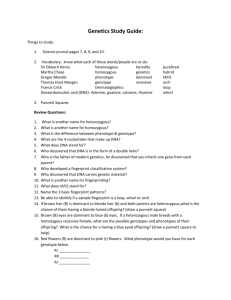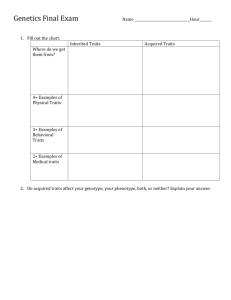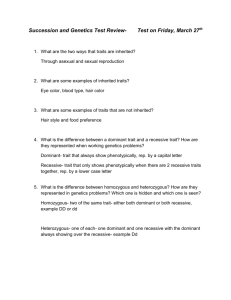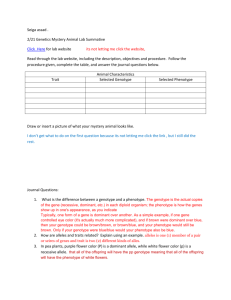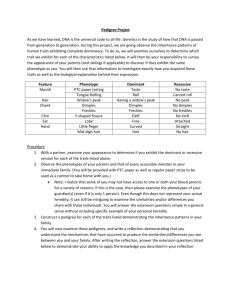Human Genetics Lab Student Name
advertisement
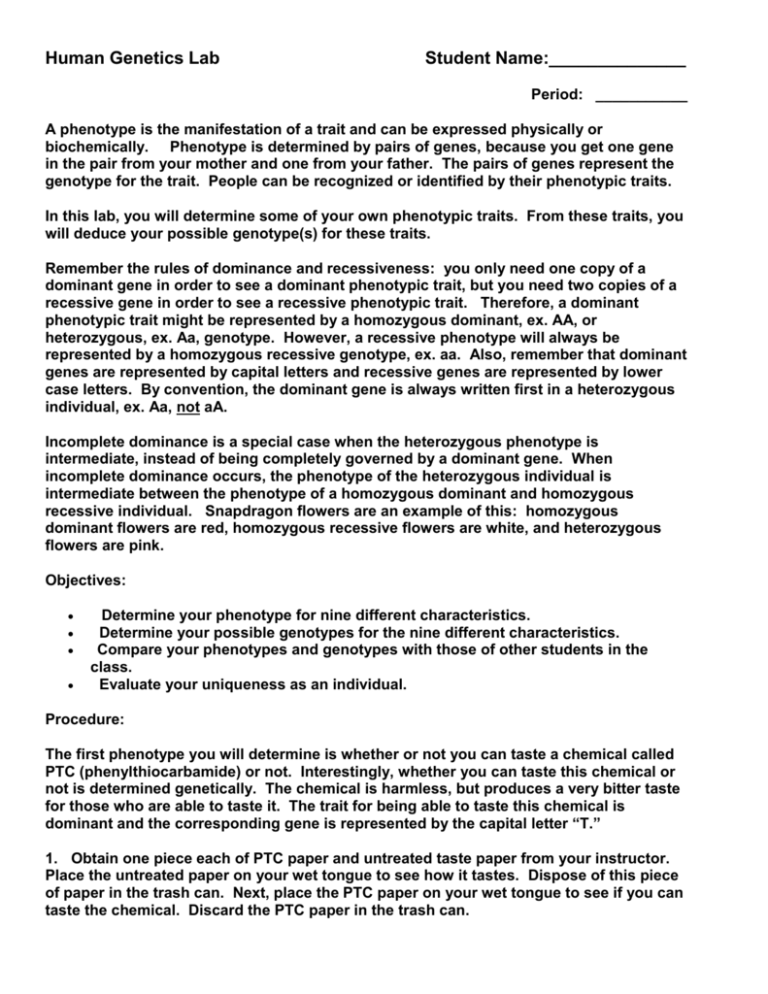
Human Genetics Lab Student Name:______________ Period: ___________ A phenotype is the manifestation of a trait and can be expressed physically or biochemically. Phenotype is determined by pairs of genes, because you get one gene in the pair from your mother and one from your father. The pairs of genes represent the genotype for the trait. People can be recognized or identified by their phenotypic traits. In this lab, you will determine some of your own phenotypic traits. From these traits, you will deduce your possible genotype(s) for these traits. Remember the rules of dominance and recessiveness: you only need one copy of a dominant gene in order to see a dominant phenotypic trait, but you need two copies of a recessive gene in order to see a recessive phenotypic trait. Therefore, a dominant phenotypic trait might be represented by a homozygous dominant, ex. AA, or heterozygous, ex. Aa, genotype. However, a recessive phenotype will always be represented by a homozygous recessive genotype, ex. aa. Also, remember that dominant genes are represented by capital letters and recessive genes are represented by lower case letters. By convention, the dominant gene is always written first in a heterozygous individual, ex. Aa, not aA. Incomplete dominance is a special case when the heterozygous phenotype is intermediate, instead of being completely governed by a dominant gene. When incomplete dominance occurs, the phenotype of the heterozygous individual is intermediate between the phenotype of a homozygous dominant and homozygous recessive individual. Snapdragon flowers are an example of this: homozygous dominant flowers are red, homozygous recessive flowers are white, and heterozygous flowers are pink. Objectives: Determine your phenotype for nine different characteristics. Determine your possible genotypes for the nine different characteristics. Compare your phenotypes and genotypes with those of other students in the class. Evaluate your uniqueness as an individual. Procedure: The first phenotype you will determine is whether or not you can taste a chemical called PTC (phenylthiocarbamide) or not. Interestingly, whether you can taste this chemical or not is determined genetically. The chemical is harmless, but produces a very bitter taste for those who are able to taste it. The trait for being able to taste this chemical is dominant and the corresponding gene is represented by the capital letter “T.” 1. Obtain one piece each of PTC paper and untreated taste paper from your instructor. Place the untreated paper on your wet tongue to see how it tastes. Dispose of this piece of paper in the trash can. Next, place the PTC paper on your wet tongue to see if you can taste the chemical. Discard the PTC paper in the trash can. 2. Record yourself as either a “taster” or “nontaster” phenotype in the table. 3. Now that you have determined your phenotype, you can deduce your possible genotype(s). Since tasting PTC is governed by a dominant gene, if you are a taster then your possible genotypes are TT and Tt. You must include both in your answer, because without further testing or pedigree analysis (looking at the traits of your family members) you cannot tell if you are homozygous dominant or heterozygous for the trait, just that you do carry the dominant gene. If you are a nontaster, then your genotype is tt. 4. Repeat this process for each of the following traits. Record your phenotype and possible genotype(s) in the data table, according to the instructions for dominance, recessiveness, or incomplete dominance for each trait. Here are a few examples. a. Hairline: The widow’s peak hairline comes to a point in the center of the forehead. Having a widow’s peak hairline is dominant (genotype can be WW or Ww) to having a straight hairline ( has to be ww). b. Eye shape: Almond-shaped eyes are dominant (A) to round-shaped eyes (aa). c. Eyelash length: Long eyelashes are dominant (E) to short eyelashes (e). d. Tongue-rolling: The ability to roll the tongue is dominant (C) to the inability to roll the tongue (c). e. Thumb: The hitchhiker’s thumb (thumb tip bends backward more than 30 degrees) is dominant (B) to a straight thumb (b). f. Lip Thickness: Thick lips are dominant (L) to thin lips (l). g. Hair Texture: Curly hair is incompletely dominant (HH) to straight hair (SS). Those who have wavy hair are intermediate (HS). h. Inter-eye Distance: Close-set eyes are incompletely dominant (DD) to eyes set far apart (FF). Medium-set eyes are DF. i. Lip Protrusion: Protruding lips are incompletely dominant (PP) to nonprotruding lips (NN). Slightly protruding lips are intermediate (PN). Data: Human Phenotypes and Genotypes Check only one: Trait PTC Taste Hairline Eye Shape Eyelash Length Tongue Dexterity Thumb Lip Thickness Hair Texture Inter-Eye Distance Lip Protrusion Your Phenotype Possible Genotype(s) Dominant Recessive Intermediate Questions: 1. Which traits do you have that are dominant? (list them) 2. Which traits do you have that are recessive? (list them) 3. Which of your traits are governed by incomplete dominance? 4. Which of your traits do you share with one or more of your classmates? 5. Which of your traits are unique to you? 6. What determines your traits (i.e., how do you acquire them)? 7. With knowledge of the phenotypes of a human, how can a person’s genotype be determined (i.e., how did you determine your possible genotypes today – what knowledge did you use)? 8. Why was untreated paper used in the PTC taste test?



